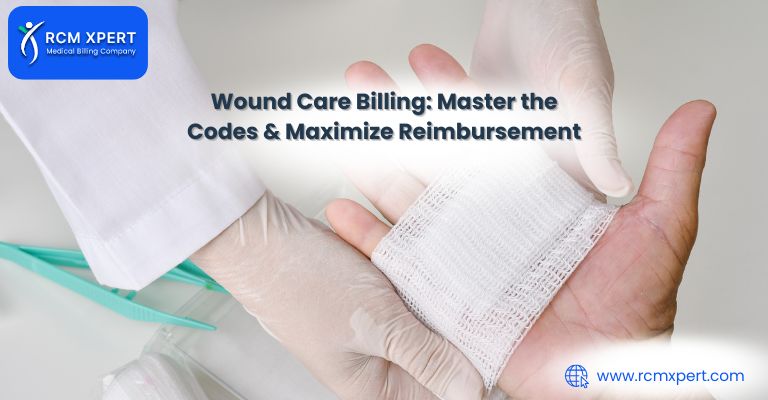The complexities of healthcare, especially in precise wound care coding and billing, require a detailed understanding of current billing codes, including CPT codes and wound care revenue codes. To achieve accurate reimbursement, it is critical to match the services provided with the correct wound care billing codes.
This guide will help healthcare providers and medical coders to understand Essential strategies and current codes with the knowledge needed to optimize their billing processes and achieve accurate reimbursement for wound care services.
Understanding Wound Classification and Billing
- Different wound types and their corresponding billing codes: Accurate wound care coding is pivotal for billing. This section highlights different wound types and their billing codes, underscoring the need for precise classification.
| Wound Type | ICD-10 Codes | Description |
| Pressure Injuries | L89.0 to L89.9 | Requires documentation of the injury’s stage for appropriate billing. |
| Diabetic Ulcers | L97.4, E10-E13 | Coding should reflect ulcer location and severity, affecting reimbursement rates. |
| Venous Ulcers | I83.2 | Highlight the cause and specifics of the ulcer for accurate coding. |
| Arterial Ulcers | I70.2 | Detailing the cause and characteristics of the ulcer is essential for proper billing. |
| Surgical Wounds | T81.3x | Codes vary based on wound origin and care complexity, important for postoperative care billing. |
| Burns | T20-T31 | Specify degree, location, and extent. Classification impacts billing for treatment and follow-up care. |
| Traumatic Wounds | S00-S99 | Report according to wound type, location, and causative event for accurate claims related to accidents or violence. |
- Importance of accurate wound classification for proper coding.
Understanding wound care coding not only ensures compliance but also maximizes the financial outcome for healthcare providers.
| Wound Classification | Importance of Proper Coding |
| Pressure Injuries | Accurate staging is essential to ensure appropriate billing for the level of care needed. |
| Diabetic Ulcers | Precise location and severity documentation directly affect reimbursement rates. |
| Venous and Arterial Ulcers | Identifying the cause and specifics of the ulcer is crucial for accurate coding and billing. |
| Surgical Wounds | Complexity and origin documentation determine the correct postoperative codes to use for billing. |
| Burns | Degree, location, and size must be specified for appropriate treatment billing and follow-up care. |
| Traumatic Wounds | Type, location, and event details are necessary for correct accident or violence-related claims. |
Essential CPT Codes for Wound Care Services
In wound care coding, selecting the right CPT codes is crucial for accurate billing. This section covers the key CPT codes used for common wound care procedures, including debridement and dressing changes.
| CPT Code | Procedure | Application |
| 11042 | Debridement, subcutaneous tissue; first 20 sq cm or less. | Removing dead or infected tissue to promote healing in shallower wounds. |
| 11043 | Debridement, muscle, and/or fascia; first 20 sq cm or less. | Applicable for deeper wounds requiring more extensive cleaning beyond the subcutaneous layer. |
| 97597 | Removal of devitalized tissue from wound(s), non-selective debridement, first 20 sq cm or less. | Suitable for regular wound care management, involving cleaning and removal of non-viable tissue. |
| 97598 | Each additional 20 sq cm, or part thereof (in addition to code for primary procedure). | For wounds exceeding 20 sq cm, indicating a need for extensive care and management. |
This table outlines essential CPT codes for wound care services, providing a concise explanation for each and guidance on when they should be used to ensure accurate wound care coding and billing.
Utilizing Modifiers to Enhance Billing Accuracy
Modifiers play a crucial role in wound care coding by providing additional details about the service rendered, such as wound size, location, and complexity. This segment highlights the importance of modifiers and offers examples for precise wound care billing.
- Modifiers in Wound Care Coding: Modifiers help clarify the specific aspects of wound care services provided, ensuring accurate reimbursement. They detail the extent of procedures and adjust payment policies accordingly.
- Examples of Modifiers:
| Modifier | Description | Application in Wound Care |
| -22 | Increased Procedural Services | Used for services significantly more complex than usual, such as extensive debridement due to wound complexity. |
| -59 | Distinct Procedural Service | Indicates procedures not typically billed together but appropriate under the circumstances, like multiple wounds in different locations. |
| -76 | Repeat the Procedure by the Same Physician | Applied when a procedure is repeated on the same day, reflecting the need for repeated wound care interventions. |
| -LT, -RT | Left Side, Right Side | Denote services performed on either the left or right body part, crucial for specifying wound location for accurate billing. |
Avoiding Common Billing Errors and Ensuring Reimbursement
Frequent mistakes in wound care billing, such as incorrect coding and inadequate documentation, can delay reimbursement. This section offers strategies to avoid these errors and ensure successful claims submission.
Incorrect Coding: One of the primary errors in wound care billing involves using incorrect codes. Always double-check codes against the latest CPT and ICD-10 guidelines to ensure accuracy.
Inadequate Documentation: Another common pitfall is failing to provide comprehensive documentation that supports the billing codes used. Ensure that all documentation is detailed, including wound size, depth, type, and treatments applied.
Tips for Error Prevention:
- Stay Updated: Regularly update your knowledge of wound care coding and billing regulations to prevent the use of outdated codes.
- Thorough Documentation: Document every aspect of wound care provided, including photographs when appropriate, to support the codes billed.
- Use Checklists: Implement checklists for coders and billers to review before submitting claims, ensuring all necessary information is included and accurate.
- Regular Training: Invest in ongoing education and training for your billing team to keep them informed about the latest wound care coding guidelines and billing practices.
Importance of Detailed Documentation for Wound Care
Thorough documentation is vital in wound care coding to substantiate medical necessity and facilitate accurate billing. This segment outlines what specific aspects need documentation in wound care notes.
Supporting Medical Necessity: Complete documentation is essential to justify the medical necessity for wound care services. It serves as proof of the treatments provided and their relevance to the patient’s condition.
Examples of What to Document:
- Wound Description: Note the wound’s location, size (length, width, depth), appearance (color, presence of necrotic tissue), and stage or grade. This detail supports the choice of treatment and coding.
- Treatment Provided: Document all treatments applied, including debridement, dressing changes, and application of topical agents. Specify the products used for a clear billing trail.
- Patient Response: Record the patient’s response to the treatment, including any improvements or complications. This information is crucial for ongoing care planning and justifies continued treatment.
- Healing Progress: Note changes in wound size, depth, and overall appearance over time. Progressive documentation demonstrates the efficacy of the wound care regimen, supporting the necessity of services.
- Pain Assessment: Include pain scores and patient feedback about discomfort. Pain management is a key component of wound care that needs to be accurately documented.
Staying Compliant with Medicare Wound Care Billing Guidelines
Compliance with Medicare billing guidelines for wound care ensures accurate reimbursement and avoids audits. Here are insights into adhering to these guidelines and where to find the latest updates.
Adherence to Guidelines: Medicare has precise requirements for wound care coding and billing. Understanding and following these guidelines is crucial for healthcare providers to ensure they are fully reimbursed for the wound care services provided.
Resources for Updates:
- CMS Website: The Centers for Medicare & Medicaid Services (CMS) website is the primary source for any updates or changes in billing guidelines.
- Professional Associations: Organizations such as the American Medical Association (AMA) and the American Health Information Management Association (AHIMA) frequently provide updates and educational resources on wound care coding.
- Billing Software Updates: Ensure your billing software is up-to-date, as it often includes the latest coding changes and guidelines directly from CMS.
Conclusion
In conclusion, this guide provides healthcare providers, coders, and billing professionals with the essential knowledge for effective wound care coding and billing. Through accurate classification, adherence to CPT codes, strategic use of modifiers, and diligent documentation, you can ensure proper reimbursement and compliance. Stay informed with the latest guidelines to uphold the financial health of your practice while delivering quality care.
FAQ
1. How do I ensure accurate wound care coding?
Accurate wound care coding requires thorough knowledge of current CPT and ICD-10 codes related to different types of wounds, such as pressure injuries, diabetic ulcers, and surgical wounds. Regularly updating your knowledge base through reputable sources like the CMS website and professional associations, and ensuring detailed documentation of every wound care service provided, are key practices.
2. What common mistakes should I avoid in wound care billing?
Common mistakes in wound care billing include incorrect coding due to lack of familiarity with the latest codes, inadequate documentation that fails to support the medical necessity of treatments, and overlooking the use of appropriate modifiers that specify wound care services. Avoid these errors by double-checking codes, maintaining comprehensive treatment records, and staying informed about billing guideline updates.
3. How can I stay compliant with Medicare wound care billing guidelines?
Staying compliant with Medicare guidelines involves adhering strictly to the coding and billing requirements set forth for wound care services. This includes understanding which services are covered under Medicare Part A and Part B, using the correct wound care billing codes, and keeping abreast of changes through resources like the CMS website, billing software updates, and educational materials from health care associations.














